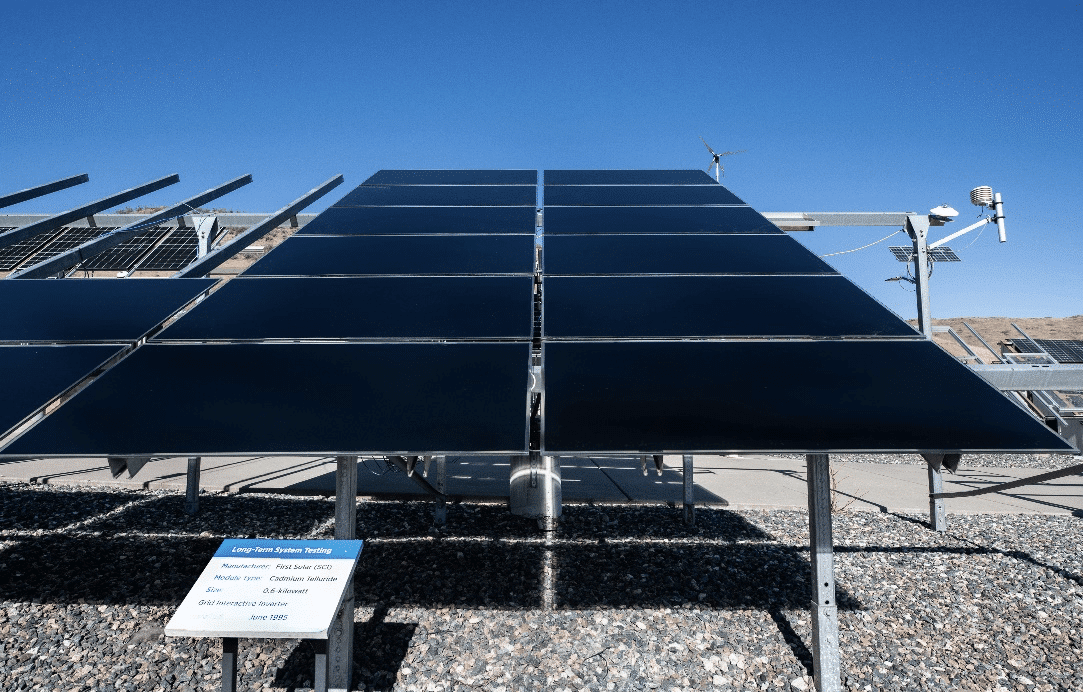From pv magazine USA
It’s 1995 and Bill Clinton is president. The only discussions of global warming are in technical papers and oil company board rooms. Gangsta’s Paradise by Coolio is No. 1 on the charts and Waterfalls by TLC is No. 2. The United States leads the world in solar panel production, with 35 MW built.
That’s the same year that cadmium telluride solar panels built by First Solar’s earlier incarnation, Solar Cells Inc., were installed at NREL’s outdoor test facility (OTF) in Golden, Colorado.
Those panels are still performing, as is First Solar — unlike most of the 1995-vintage vendors that planted their panels at NREL in the previous century, such as Shell, Amoco, and Arco.
NREL’s OTF
First Solar’s thin-film solar modules hit 25 years of continuously monitored performance testing – as part of the longest-running research project at NREL’s OTF. While the OTF is equipped to perform accelerated testing, nothing is a match for years in the field. NREL uses multi-year outdoor testing to validate its accelerated testing. A solar module with a longer lifetime produces more value and less waste.
The nearly 40 test beds surrounding the OTF building allow researchers to chart the electrical output performance of PV modules under outdoor conditions. They can use the OTF to test the long-term performance and stability of PV modules and systems under standard and accelerated outdoor conditions. In addition, they can measure the performance of hybrid systems, according to NREL.
One I-V system used by the researchers to measure the electrical output performance of PV modules under outdoor conditions (and as close as possible to standard test conditions) is the Standard Outdoor Measurement System. This is a fixed system on which modules are placed for testing and can track the sun. NREL looks to make measurements under a clear sky, with irradiance between 950 and 1,050 W/m2, and as close to 25 C as possible.
Test results
Popular content
First Solar’s origin story includes Department of Energy funding to research cadmium telluride PV technology in the early 1990s. Among the companies involved in the research was Solar Cells Inc., which later became First Solar.
“We always intended to keep the modules/arrays installed at the OTF as long as the technologies were relevant to get very long-term reliability data,” said Ben Kroposki, an NREL engineer who installed the initial PV modules for First Solar at the OTF.
The initial studies on First Solar’s panels revealed that after five years, the company’s panel degradation amounted to a relative 0.6% a year. NREL now finds, 25 years later, that the long-term degradation of the studied modules was 0.5% a year, with an efficiency, today, of around 88% of the original panel performance.
Louis Trippel, VP of product management at First Solar, added that the lessons learned from the testing at NREL provided “incremental confidence to help support a recently announced extension” of its module power output warranty from 25 years to 30 years. First Solar’s modules are warranted at 0.5% degradation per year – but the company “guides” to 0.4%.
NREL has also worked with silicon high-efficiency solar panel builder SunPower (now Maxeon) to develop a method to calculate solar panel degradation. After eight years of energy performance data, SunPower panels were shown to degrade at a median rate of 0.2% per year. Trina Solar provides a 30-year linear warranty and a 0.5% annual degradation rate for its silicon solar panels.
But most solar companies haven’t tested their panels for the actual duration of the warranty term.
For the full story, please visit our pv magazine USA website.
This content is protected by copyright and may not be reused. If you want to cooperate with us and would like to reuse some of our content, please contact: editors@pv-magazine.com.



Thank you, a very informative article. Thanks again.
Our first solar panels were purchased during Jimmy Carter’s administration. Our second were from the Carizzo power plant. We bought used around the early 80’s I think they were already 20 years old. All still producing power. Bout the best investment we ever made. No power bills for 39 years.
Fantastic, Marcia.